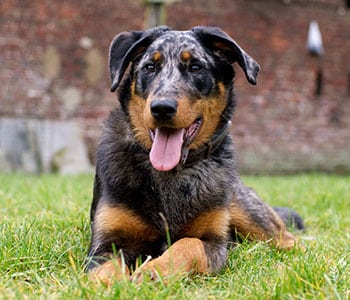The Beauceron is a guard dog and herding dog breed falling into the working dog category whose origins lie in the plains of Northern France. The Beauceron is also known as Berger de Beauce or Bas Rouge

Jump to:
Beauceron Facts: History
A French herding breed known for centuries in Western Europe, the Beauceron is noted as one of the breeds used to create the Doberman Pinscher. The regional name is somewhat misleading: the breed was found throughout northern France rather than just in the Beauce region. Although quite different in appearance, the Beauceron and the long-haired sheep dog, the Briard, stem from similar ancestral stock, sharing the trait of double dewclaws on the hind legs. Both were used to herd sheep and cattle. Like the Beauceron, the Briard is found throughout northern France, and despite implications from its name, also did not come exclusively from the Brie region.
In 1809, Abbé Rozier wrote an article on these French herding dogs, in which he described the differences in type and used the terms Berger de Brie and Berger de Beauce.
In 1893, veterinarian Paul Megnin differentiated between the long-haired Berger de la Brie and the short-haired Berger de Beauce. He defined the standard of the breed with the assistance of M. Emmanuel Ball. In 1922, the Club des Amis du Beauceron was formed under the guidance of Dr. Megnin.
In 2008, the Beauceron made its debut in the Westminster Kennel Club Dog Show.
A versatile breed, the Bas Rouge is used to both guard and herd sheep and cattle. It was once very useful against wolves, now long gone from northern France. The breed served in both world wars as a messenger dog, supply transport dog, land mine detection dog, search dog, police dog, and rescue dog.
Beauceron Facts: Temperament
The Beauceron is a confident, smart, strong-willed dog. He is protective of his family and territory and is usually reserved with strangers. He is easily trained but often shows his independent side. Though self-assured, the Beauceron should not be aggressive. He is gentle but fearless.
The Beauceron is loyal to his people. When he is raised with children, he can be good with them. Don’t forget that he is a herding breed and might chase or nip at children. This should never be permitted. He is best suited to a family with older children who can understand how to treat him with respect.
It’s almost impossible to wear out a Beauceron. Choose this breed only if you are a high-energy person yourself who enjoys active daily exercise such as running, bicycling, and hiking and can take your dog with you. He’s also well suited to just about any dog sport, including agility, flyball, herding, obedience, rally, search and rescue, and tracking. A bored Beauceron is a destructive Beauceron.
Begin socialization and training early to make the most of Beauceron’s intelligence, rapid learning ability, and drive. Use positive reinforcement techniques such as praise, play, and food rewards. Remember that he is an independent thinker. Be prepared for him to push back when you ask him to do something, testing whether you really mean what you say. It’s essential to be firm, fair, and consistent. Never use harsh treatment or force.
Beauceron Facts: Health
Beaucerons are generally healthy dogs, but it is important to keep an eye out for allergies and dermatomyositis, an inflammatory condition that can affect the skin, muscles, blood vessels, and fat. They may also be prone to gastric torsion.
